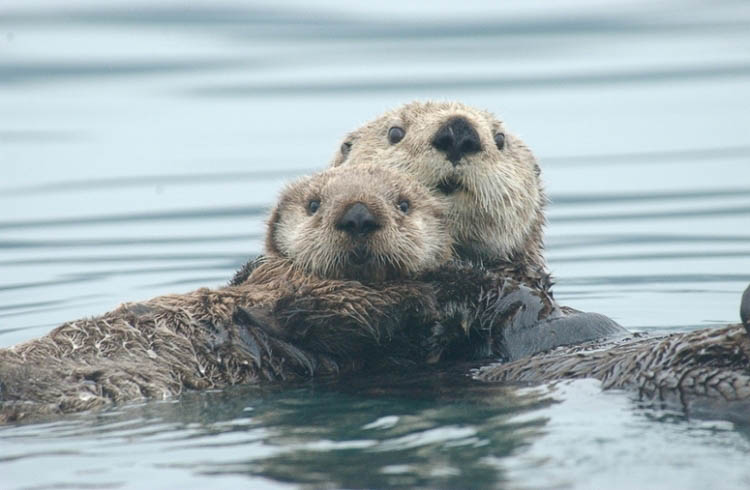Deep Dive: A&M-Galveston Regents Professor Develops Catalog of Aquatic Animal Research Over Impressive Career
 A female sea otter and her pup float together in Prince William Sound
A female sea otter and her pup float together in Prince William Sound The photo Dr. Randall Davis points to is comical. A Weddell seal seems to look questioningly at the camera while a nearly full-sized Sony camcorder in plastic housing is strapped to its head.
“The early technology was pretty crude,” Davis says with a laugh. “Now the instruments are much smaller and easier to affix. That’s the kind of work I do, mostly in the Antarctic.”
Davis is a Regents Professor in the Department of Marine Biology at Texas A&M University at Galveston. Throughout his lengthy career, he’s visited all of the world’s oceans, been inducted into the storied Explorers Club, lived a year in Antarctica, studied seals, sea otters, sharks, whales, porpoises, penguins and more. He’s always been fascinated by the physiology and behavioral ecology of marine animals, meaning their day-to-day functions, as well as their internal and external makeup within the context of their aquatic environments.
“The goal is instrumenting these animals to get a better idea of their organic behavior and physiology in unrestrained, free-ranging conditions. To understand how an animal is behaving, you really have to study it in its natural environment. And you find there are oftentimes unanticipated behaviors that suddenly make sense that you never could have forecast if working with a captive animal,” Davis explained.
Studying aquatic animals is an added challenge. It’s fairly simple to study a terrestrial animal hunting prey using a scope or binoculars to observe the behavior, but when marine mammals dive 500 to 1,000 meters in depth, and in freezing waters, it becomes infinitely more difficult.

“So the way we do it is we put instruments and video cameras on them so we can travel vicariously with them and see these animals dive. We’ve been doing it since the 80s. There’s almost no other way to track this. It allows us to see what they’re doing, seeing, what they’re eating and how; we track them in three-dimensional space from their perspective,” he said.
With this footage and the data derived from it, researchers can now classify and distinguish the behavioral functions of different dive types and describe foraging strategies and hunting tactics in detail. Within a larger context, this helps the scientific world better understand these animals from a holistic standpoint and how and why they have the adaptations they do.
Davis’ research has led to new discoveries and insights into multi-level adaptations, from biochemistry to behavior, for breath-hold diving in marine mammals and other aquatic vertebrates.
But that’s not all.
Davis is also involved with a project in China regarding the Yangtze finless whale, a critically endangered river-dwelling cetacean. Davis is working in tandem with multiple agencies supported by the Chinese government to prevent the extinction of the species.
Currently, he and marine biology graduate student Preston Chang are studying the thermoregulation (the process that allows the body to maintain its core internal temperature) and submerged swimming habits of the finless whale. In a captive environment in Wuhan, China, they put the animal under a dome so as to study its breathing before and after it dives.
“We then go out and look with drones at their wild counterparts and look at the swimming and breathing patterns and put together estimates, photos and catalog that data,” he said.
That’s still not all.
Davis is one of the foremost experts on oiled sea otters in the world. He quite literally wrote the book on the unfortunate subject, Emergency Care And Rehabilitation of Oiled Sea Otters: A Guide For Oil Spills Involving Fur-Bearing Marine Mammals.
In the 1980s, Davis conducted research in Alaska for the U.S. Department of the Interior developing techniques to mitigate the effects of oil on sea otters. Then, in 1989, the Exxon Valdez oil spill devastated the animal inhabitants of Prince William Sound.
“The Department of the Interior in Alaska’s entire animal oil spill response plan was my name and phone number,” Davis recalled. “So began a six month-long effort to capture, clean and rehabilitate as many oiled sea otters as we could. We came up with a method, we tested on pelts and live animals, the product that works the best is Dawn, like the commercials show.”
Davis’ team ended up capturing 320 otters and rehabilitating and releasing 220. They lost 100 to the toxic effects of the oil. Davis still advises the organization that oversees that particular terminal and has trained a roster of over 200 volunteers on sea otter oil response and rehabilitation techniques. He even has an undergraduate class in this area now, MARB 415 : Coastal Marine Biology and Geology of Alaska.
This is not his latest work, though; that would be the new book he just had published in mid-November.
Marine Mammals: Adaptations for an Aquatic Life covers all aspects of physiological and morphological evolution of marine mammals. Davis’ third book is a compilation of what it takes to become an aquatic mammal and to live continuously or a large portion in a marine or freshwater environment. He’s excited to offer the new text to his students, and free of charge.
Davis says finding the time to write this particular resource was exhausting but rewarding, much like his career. Though he mentions that he feels he’s closer to the end than the beginning, does he see a stopping point? Don’t hold your breath.
Media Contact
Andréa Bolt
Communications Specialist
a_bolt@tamug.edu